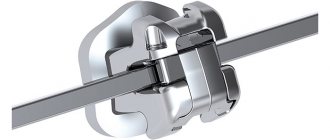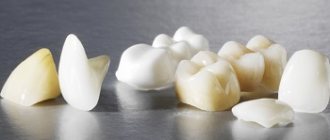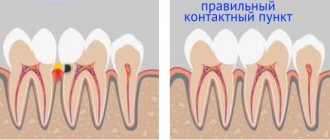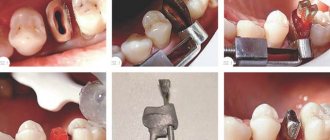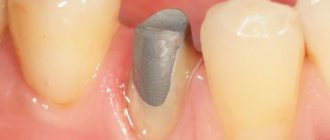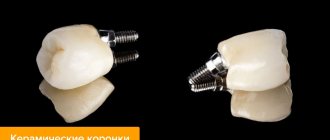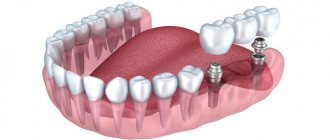Modern dental methods for restoring dental aesthetics will allow you to restore the beauty of your smile for many years quickly and painlessly. To eliminate extensive defects in the dentition, ceramic inlays are used on the tooth. In appearance, they are not much different from natural tooth enamel. With the help of the design, it is possible not only to restore the aesthetic characteristics of the units, but also to protect them from further destruction under the influence of caries and mechanical loads.
Ceramic inlays can last 10 years without shrinkage or deformation. They are created in special dental laboratories individually for each patient. The materials used to create structures are characterized by increased strength and resistance to external irritants. Installation of the tab takes place over several visits to the dentist (2-3 procedures). The cost of the dental procedure in question usually exceeds the price of a standard filling of decayed units.
What are they?
A ceramic inlay is a fragment that replaces the lost part of the teeth. They are designed to restore crowns that have been destroyed by more than 30%, and in cases where the use of conventional filling materials is not possible.
Products differ from each other in material of manufacture, production method and performance indicators. The inlay completely follows the shape and size of the teeth, protecting them from further destruction. The structure can be placed on both the external and internal sides of the teeth.
Comparison of ceramic inlays and similar products made from other materials
Such restoration prostheses today are created from different materials. The choice of a specific type depends on many factors, including the location of the damaged element, aesthetic and functional requirements for the prosthesis. Let's briefly look at the main varieties:
- composite is a photopolymer light-curing material, exactly the same one used to create fillings. The only difference is that a composite product is created from casts in the laboratory, resulting in a more accurate and durable design,
- pressed ceramics - a more durable and reliable option, has high aesthetic characteristics,
- porcelain (feldspathic ceramics) - more porous than pressed, and therefore less reliable and durable,
- metal-ceramics - it is based on metal or a precious alloy, coated with a ceramic mass, a fairly good solution in terms of strength and aesthetics. This material is more recommended for creating full-size single dentures, but metal-ceramic inlays for teeth are not popular among dentists,
- Zirconium dioxide is the best quality option, but it is also more expensive. The material is characterized by the highest strength and excellent aesthetics.
“I have a zirconium insert on my six, an excellent option, in my opinion. I thought I would have to put a pin or something like that. And before that I already heard that these pins are a thing of the past. I really didn’t want to pay and then have to fix the tooth again 2 years later. In general, I got to a good doctor, he said I could safely put in an inlay. Everything went fine, it fits like a glove, no complaints. But for chewing teeth, of course, the material must be strong. Zirconium, as they explained to me, is the best in all respects.” Angelina89, from correspondence on the 32top.ru forum
It is also worth telling in more detail about some of the nuances of using dental ceramics to create microprostheses. Just 30-40 years ago there were no modern advanced technologies that would have made it possible to create the most reliable and durable all-ceramic solutions for recreating damaged crowns. The material was actively used, but it did not have the required degree of strength, so it was only suitable for restoring the smile area.
Metal-ceramic inlay
Today, to create inlays, they mainly use special ultra-strong pressed ceramics or zirconium dioxide processed using CAD/CAM technology, that is, using fully automated high-precision equipment. In this case, the specialist loads the patient’s individual data into the software milling module, after which the device literally cuts out the product of the desired shape and size from a single block of material. Such microprostheses are considered the most durable, aesthetic and reliable1.
Indications and contraindications
The main indications for restoring the aesthetics of elements using structures:
- increased abrasion of enamel;
- severe mechanical damage to the crown of the tooth;
- destruction of the crown by more than 30%;
- the need to use the unit as a support for the prosthesis;
- using ceramic inlays instead of fillings.
The products are an improved version of fillings that are made to order. Installation of structures is not possible in all cases.
Contraindications for the procedure are:
- the need to restore milk elements;
- destruction of the crown by more than 60-70% (in this case, doctors offer crowns to patients);
- lack of a healthy root system of the tooth;
- serious mechanical damage to the unit, in which nothing remains of it;
- destruction of incisors or canines (inlays, as a rule, are not used for the restoration of these elements);
- progression of carious processes in the oral cavity.
Photos before and after installing a ceramic inlay
Experts also do not recommend restoring wisdom teeth using ceramic structures. Eights do not play any role in the process of chewing food and are invisible to others, so there is no point in spending money on their expensive restoration.
Tooth restoration with an inlay: installation stages
- Initial consultation.
Identification of indications and contraindications for the installation of a ceramic inlay. - Pre-treatment (if necessary).
Before installing a microprosthesis, it is necessary to cure dental diseases. Often we are talking about deep caries, pulpitis and periodontitis. - Preparing the cavity for the tab.
The tooth is prepared using a drill. Carious tissue, broken tooth fragments, old fillings, etc. are removed. After this, the dentist carries out final processing and grinding. - Taking impressions.
Taking impressions can be done manually using special impression materials or using an intraoral scanner - advanced technology, thanks to which the doctor receives a digital impression and can work with it in a special program at the modeling stage. - Making a tab.
The production of ceramic inlays is carried out in two ways - injection molding or CAD/CAM technology. In the second case, the production of the tab is faster, and the process itself is fully automated. However, the use of CAD/CAM technologies requires very expensive equipment. - Fitting and fixing
a porcelain inlay into a tooth.
The difference between an inlay and a filling
Which is better: a filling or an inlay? The main distinguishing characteristics between the two types of products are discussed in the table below.
| Characteristic | Tab | Seal |
| Mode of production | Created indirectly in a dental laboratory using a three-dimensional model | Created directly in the patient's mouth |
| Production time | From several days to several weeks | One day |
| Number of visits to the doctor for installation | 2-3 visits, depending on the complexity of the clinical case | 1 visit for uncomplicated caries |
| Restoration zones | Chewable units | Any teeth |
| Quality of adhesion to enamel | Perfect | Shrinkage possible |
| Operating time | 7-10 years | 3-5 years |
Ceramic tooth inlay: advantages and disadvantages of products
Currently, ceramic onlays are the most common method of restoring incisors, molars or premolars; they are recognized as reliable and durable. Unlike composite fillings, they are not made in the patient’s mouth, but in isolation, in a dental laboratory (using impressions). This allows you to create an anatomically correct tooth shape with increased accuracy. This factor is very important for the area of contact with the adjacent incisor, molar or premolar. The use of ceramic inlays makes it possible not to resort to crowns if the root bases of the teeth are intact. The main advantages of the products include:
- high aesthetic qualities. Ceramic onlays are no different from natural molars or premolars. The material fully matches their visual characteristics. Only a specialist can notice the difference upon careful close examination;
- durability (compared to a conventional filling). If you follow all the recommendations prescribed by your doctor, the orthopedic design can last more than 10 years. For comparison, a regular filling lasts about 3-4 years;
- no changes in appearance. Ceramics do not darken over the course of a year, so the original color remains intact for the entire duration of wear. It is completely resistant to dyes and other external factors;
- no shrinkage and polymerization after fastening. The main factor influencing the development of secondary carious lesions is pathogenic microorganisms that enter the gap between dentin and filling material. It occurs as a result of shrinkage of the filling. Under the influence of ultraviolet radiation, the filling significantly decreases in volume and sags. e max structures retain their dimensions and do not change during the manufacturing and installation process. Their grinding occurs at the same time as the tooth tissues;
- complete safety. The material does not have a negative effect on the human body and does not provoke the development of allergic reactions;
- high strength. Unlike conventional fillings (light, chemical), the inlay is more securely fixed and is characterized by increased resistance to mechanical and thermal stress.
The emax ceramic inlay has no significant disadvantages. Some are confused by the time spent on manufacturing and installing orthopedic structures, which, unlike conventional fillings, require several visits to the dentist's office. Relative disadvantages include the high price (compared to inlays made of other metals). It is worth noting that their quality, aesthetics and long service life justify their relatively high cost.
Pros and cons of tabs
Ceramic inlays have a number of advantages compared to other methods of restoring teeth. The advantages of a ceramic tooth inlay include:
Veneers on teeth: pros and cons
- the ability to mask large cavities and destroyed fragments;
- no need to adjust the size of the product due to its exact fit (seals do not meet these criteria);
- no staining from food or changes in original external characteristics;
- minimal risk of developing allergic reactions due to the high biocompatibility of the materials of the inlay and the oral mucosa;
- stability and strength, which makes it possible to consume familiar food products, including hard ones (nuts, seeds, crackers);
- no discomfort during operation.
Inlays also have a number of disadvantages, among which patients highlight:
- long recovery period after the procedure;
- the need to wait for the production of products;
- high cost of restoration;
- the need for several visits to the clinic.
What is made from e-max ceramics?
The latest generation of metal-free ceramics e-max is used in various areas of dentistry. Thanks to its unique properties, it displaces many other materials, especially since Ivoclar Vivadent is constantly improving its products and developing new technologies. e-max technology is used to create the following dental structures:
- Veneers e-max. These are thin plates designed to correct external dental defects and improve your smile. Such designs are durable, highly aesthetic and do not cause an allergic reaction. Over the years, they retain their original appearance and do not darken or turn yellow.
- All-ceramic crowns. They are no different from living teeth and match the shade of natural enamel. This type of prosthesis is indicated for those patients who are allergic to metal. With proper care, crowns made using e-max technology will last a lifetime.
- Ceramic inlays. They are much stronger than conventional composite fillings, are made individually for each patient, are securely fixed in the oral cavity and perfectly imitate natural dentin. Most often, e-max technology is used in the A-medic clinic specifically to create inlays, so we will tell you in more detail about these microprostheses.
Kinds
There are 3 main types of inlays, which differ in material of manufacture, service life and cost. The modern type of material from which products are made is metal ceramics. Their cost is not much different from ceramic structures, but in quality they are significantly inferior to them. Cermet inlays may fall out when exposed to too high or low temperatures. This is due to the ability of the metal to expand under the influence of temperature factors. For this reason, dentists do not advise patients to resort to modern methods of dental reconstruction.
Inlays can also be made from pressed ceramics. Porcelain is used to produce structures of the required shape and size under the influence of high temperatures. As a result of laboratory work, inlays are durable and resistant to external influences. In terms of strength, they are not inferior to zirconium samples. Ceramic structures are recommended for use in cases of significant destruction of dental elements.
Zirconium is another material used to make inlays. The resulting products are in no way inferior to porcelain in terms of technical characteristics. They are turned on modern machines using pre-prepared plaster models. All stages of work are controlled automatically by high-precision devices.
It is allowed to use stump products to restore a completely destroyed coronal part, provided that the tooth root is preserved. After the procedure, a crown or bridge is attached to the tab
Depending on their purpose, structures are divided into restorative and stump. The former allow you to restore the integrity of the tooth crown with a healthy root system.
General overview
The term inlay in dental practice refers to a type of microprosthesis used in the event of significant destruction of tooth tissue as a result of mechanical trauma or the development of a certain disease, for example, caries.
In terms of production technology, this design differs from a filling only in that it is made in a dental laboratory using a pre-made cast of an element of the patient’s jaw row.
Ceramic inlays have a long service life, and in appearance they completely copy the anatomical features of your own teeth that need restoration.
These permanent prosthetic structures restore the functionality and aesthetics of the units, preventing their further destruction and damage to adjacent teeth.
Installation technique
Reconstruction of row elements using ceramic inlays occurs in stages:
- First, old fillings (if any) are removed. Teeth preparation occurs using a cooling system that prevents overheating of bone tissue. Grinding of the restored unit often occurs with the use of magnifying dental instruments (binocular glasses). Thanks to them, the doctor will be able to preserve a larger volume of healthy dentin tissue.
- After preparation, the resulting cavity is processed with a caries detector. The method allows you to identify the affected areas remaining after preparation.
- Precision grinding and smoothing of tooth edges with Arkansas stone. The steps of the procedure are necessary to ensure a good fit of the ceramic inlay.
- After this, an impression is taken from the problem unit, from which the dental technician will create an inlay. Checking the compliance of the parameters of the inlay with the resulting cavity is also carried out using binocular glasses.
At the last stage, the manufactured product is attached to the tooth. Various adhesives are used for this purpose. After installation of the structures, the patient will need to adhere to a number of rules in order to extend the life of the inlays.
Private clinics practice a new method of dental restoration using the Chairside technique, which allows you to restore the aesthetics of your smile in one visit to the dentist.
During the procedure, the dentist uses a device equipped with a three-dimensional camera. Powder is applied to the work area before taking the photo. This makes the image more accurate and clear. The 3D device transmits the resulting image to a large screen and uses it to calculate the parameters of the future tab. All data is transmitted to the grinding unit, which grinds the product. The procedure takes no more than 30 minutes.
When is the best time to choose a ceramic inlay?
Everyone is familiar with the method of restoring the crown of a tooth by filling it with a composite material. In this case, it fills the entire cleaned carious cavity of the tooth layer by layer. However, with a large volume of damage, when the size of the cavity becomes significant, the doctor does not undertake such a procedure. Given these clinical conditions, there is a risk that, due to even slight shrinkage of the material, it is difficult to prevent chipping of the tooth wall.
If it is necessary to restore large areas of a tooth, experts consider using a ceramic inlay instead of a filling as the best solution. This will provide not only a long-lasting result, allowing you to significantly extend the life of the tooth, but also fully guarantees its aesthetic impeccability.
Service life and care features
Dentists claim that the maximum service life of ceramic inlays is 5 years, but this time can be extended with proper care of the product. Many manufacturers offer a 10-15 year warranty on zirconia and pressed ceramic products.
In order to carry the tab as long as possible, you must:
- brush your teeth 2 times a day for at least 2-3 minutes;
- rinse the mouth with special solutions or water after eating;
- refuse actions associated with strong pressure on the jaws and closing them together;
- Visit the dentist at least once every 6 months.
Care and possible complications
For the entire period of production of the ceramic inlay, the tooth cavity is filled with a temporary filling, so the patient must be quite careful, otherwise there is a risk of the filling falling out and damaging the tooth, which without a prosthesis becomes very vulnerable. After the inlay has been installed, the doctor usually advises you to avoid eating solid foods for at least a couple of days, and also not to clench your jaw too hard. No special care for the inlays is required - it is enough to carry out daily high-quality hygiene and regularly make preventive visits to the doctor. Patients are often concerned about possible complications associated with the installation of a ceramic inlay. If the treatment was carried out by a qualified specialist and high-quality materials and good equipment were used, there should be no cause for concern. Most often, complications arise due to errors at the planning and manufacturing stage of the inlay.
- Untreated dental diseases that develop already under the tab.
- Ignoring contraindications to the installation of a microprosthesis.
- Wrong color selection.
- Errors in calculations and production of the prosthesis. Because of this, microgaps most often occur.
Price
Let's consider the average cost of ceramic inlays in Moscow, depending on the material they are made of. The table also shows the advantages and disadvantages of each type of product.
| Material | Price | pros | Minuses |
| Metal based ceramics | 10-15 thousand rubles. | Increased strength due to the inclusion of a metal frame | High risk of falling out of the mouth |
| Pressed ceramics | 15-20 thousand rubles. | Relative strength, high aesthetic characteristics, long service life | Risk of chipping |
| Zirconium dioxide | 25-30 thousand rubles. | Natural appearance, service life up to 20 years | High price |
In the course of life, people often encounter the appearance of chips and cracks in their teeth. Ceramic inlays, which have undeniable advantages over the traditional filling procedure, will allow you to restore the aesthetics of the element. After the treatment, the patient will not need to comply with special conditions for oral care.
Features of the ips e.max system.
Modern people think about and care about their health. A beautiful, natural smile is important to him, and in order to meet his ideal, he undergoes timely examinations with a dentist, and if problems arise, he begins treatment. Damage to the tooth structure can occur due to mechanical injuries, advanced pathologies, age-related changes and other reasons. According to Ivoclar Vivadent, IPS e.max metal-free ceramics is all we need. It was they who created this system more than 15 years ago and revolutionized aesthetic dentistry. As a result of research, it has been proven that this development has a lot of advantages, while it is easy to use and consists of several components. Depending on the specific clinical situation, the doctor selects the appropriate all-ceramic material.
Contraindications
This type of microprosthesis cannot be installed in the following cases:
- bruxism (grinding teeth in sleep);
- steep slopes of hillocks;
- rapidly progressing caries;
- deep cavity extending into dentin;
- inability to ensure complete dryness of the field.
A relative contraindication is poor oral hygiene. In what cases is it not advisable to use:
- A cavity less than 1.5 mm deep (you can get by with a filling);
- The damage has affected the cervical area of the tooth (the inlay will no longer help);
- The tooth is more than 60% destroyed (a crown is required);
- Milk tooth. It makes no sense to restore it using an inlay, since the life of the tooth is less than the durability of the microprosthesis. In addition, a vlkadka costs much more than a filling. Spending so much money to restore a tooth that will soon fall out is not advisable.
Dental ceramic inlays: features and purpose
In essence, a ceramic inlay is a kind of filling that exactly repeats the shape of the destroyed area of the dental crown and closes the resulting cavity. But at the same time, they are made in the laboratory and allow you to restore even such serious and extensive damage that fillings are powerless.
Inlays allow you to quickly, effectively and inexpensively restore teeth. Their installation is considered prosthetics, and the structures themselves are called microprostheses.
There are two types of such structures: restorative (they are used to restore the shape and color of teeth) and stump ones. The ceramic core inlay is intended for the restoration of the dental crown and can be used as a support for an artificial crown.
For ceramic inlays, indications for installation are serious damage to the coronal part (from 30%), defects that cannot be eliminated with filling material, increased abrasion of dental tissue, as well as the need to create reliable support for the bridge. For small cavities, it is not recommended to install such microprostheses; it is also undesirable to install them in case of bruxism and insufficient oral hygiene.
Are there any complications?
As noted earlier, preparing a damaged tooth for installation of an inlay involves excision of hard tissue. This is done so that the internal cavity takes on the desired shape. Due to the fact that such a procedure is very similar to a surgical operation, when preparing a tooth for an inlay, a chronic or acute form of pulpitis and secondary caries may occur.
Patients suffering from increased tooth sensitivity usually experience discomfort after installing an inlay. Opening the cavity can lead to the inlay falling out of the tooth. If this happens, you should immediately visit the dentist's office where this product was installed. If possible, you should take it with you, then the doctor will treat the surface of the tooth and glue the tab back. If the tab was lost, you will have to pay money again for production.
Are inlays better than fillings?
Like any type of treatment, it is neither good nor bad in general, but there is always a choice depending on the indications. In Russia, historically, composite filling materials have been used very widely, and there are doctors with excellent manual skills who can make anything out of them. Formally, you can even build a house from a composite, illuminated by a lamp. This allows you to expand the readings. This is more than justified in regional clinics, when the patient is short on funds or simply does not have access to the necessary equipment. In clinics with access to intraoral scanners and an in-house or independent ceramic laboratory, expanding indications is not medically acceptable. From an economic point of view, let’s say, these are borderline cases.
Our CNC milling machine.
What is a contraindication
Ceramic inlays are not used on children's baby teeth because they are inappropriate. Baby teeth last less than a ceramic microprosthesis. Also considered a contraindication is the destruction of more than 50% of the area of the natural crown or the preservation of less than 2 of its walls. If the patient suffers from bruxism, he will have to wear special protective mouth guards at night to prevent the ceramic from cracking due to strong jaw compression.
It is worth noting that in the vast majority of cases, inlays are installed only on chewing teeth - premolars (“four”, “five”) and molars (“six”, “seven”). Third molars or “eights” are rarely restored in this way, as are teeth in the frontal zone (only from the inside using pinlay restoration).
